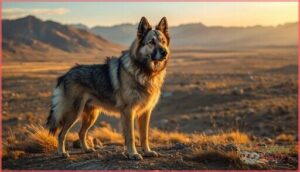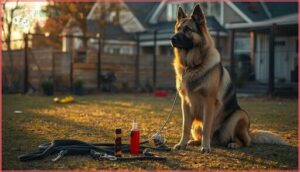This site is supported by our readers. We may earn a commission, at no cost to you, if you purchase through links.
A dog bred to face down wolves doesn’t become a household pet by accident. The Central Asian Shepherd evolved over 5,000 years across the steppes and mountains where survival meant reading threats before they materialized and standing ground when retreat wasn’t an option.
This ancient guardian carries genetics shaped not by kennel clubs, but by the brutal calculus of protecting flocks in territories where predators ruled and weakness meant death.
Today’s breed retains that hardwired vigilance—a dog that assesses, decides, and acts with the confidence of an animal whose ancestors earned their place through performance, not pedigree.
Understanding this shepherd means recognizing you’re not working with a trainable blank slate, but a partner whose instincts run deeper than obedience and whose respect must be earned through competence, not commands.
Table Of Contents
- Key Takeaways
- Central Asian Shepherd Dog Origins
- Distinctive Physical Characteristics
- Temperament and Behavior
- Health and Lifespan Considerations
- Care, Training, and Ownership
- Frequently Asked Questions (FAQs)
- Where can I find or get a Central Asian Shepherd?
- Is the Central Asian Shepherd a dog?
- What does the AKC do for Central Asian shepherd dogs?
- What were Central Asian Shepherd dogs originally bred for?
- What should I know about adopting a Central Asian shepherd dog?
- Who is Central Asian shepherd breeder Katerina?
- Are Central Asian Shepherds good with young children?
- Can they live comfortably in urban apartment settings?
- How do they behave around unfamiliar dogs outdoors?
- What is their typical barking and vocalization frequency?
- Conclusion
Key Takeaways
- The Central Asian Shepherd evolved over 5,000 years through natural selection in harsh Central Asian terrain, developing deep-rooted protective instincts and independence that make them fundamentally different from trainable companion breeds—respect must be earned through competence, not commands.
- These ancient guardians are genetically hardwired for livestock protection with territorial awareness and threat assessment abilities that operate independently of human direction, meaning you’re partnering with a dog whose instincts run deeper than obedience training can modify.
- Physical traits including their massive 88-176 pound frame, weather-resistant double coat, and bone density reflect thousands of years of adaptation to extreme climates and predator defense, making them naturally equipped for protection work without modern breeding intervention.
- Successful ownership requires significant commitment including 60-90 minutes daily exercise, early socialization to manage their territorial nature, ample space (not apartment-suitable), and understanding that their protective instincts demand structured boundaries with children, visitors, and other pets.
Central Asian Shepherd Dog Origins
The Central Asian Shepherd stands as one of the world’s most ancient guardian breeds, with roots stretching back over 5,000 years across the vast steppes and mountains of Central Asia. Understanding where this breed came from helps you see why these dogs act the way they do today—independent, fearless, and fiercely protective.
Let’s look at how this noteworthy breed developed, what it meant to the people who relied on it, and the work it was born to do.
Ancient History and Development
For over 5,000 years, the Central Asian Shepherd Dog—also called the Central Asian Ovcharka—has guarded flocks across one of the world’s harshest landscapes. This ancient breed’s nomadic roots run deep, with archaeological finds in Turkmenistan revealing dog burials from the fourth millennium BC. You’ll discover three striking aspects of this ancient lineage:
- Natural selection shaped their survival in extreme deserts and mountains
- Minimal human intervention preserved their primitive guardian instincts
- Archaeological evidence links them to royal tombs in ancient Margiana
Their dog breed history reflects genuine historical preservation through centuries of adaptation. The Central Asian Shepherd Dog’s role as a livestock guardian is a demonstration of their strength and protective nature.
Cultural Significance in Central Asia
Beyond their proven survival instincts, these dogs embody something deeper—they’re living symbols of national pride across Central Asia. In Turkmenistan, a golden Alabai statue celebrates this cultural icon. You’ll find them woven into folklore as guardian spirits, honored in festivals from Kazakhstan to Kyrgyzstan. Their nomadic heritage connects generations, transforming livestock protection into spiritual duty and tribal identity. The Central Asian Shepherd’s strong protective instincts are a key aspect of their character.
| Cultural Role | Significance |
|---|---|
| National Symbol | Gold statue introduced in Turkmenistan (2020) |
| Folklore Representation | Guardian spirit in local myths and oral traditions |
| Heritage Preservation | Special festivals and shows across Central Asia |
Traditional Roles as Livestock Guardians
While cultural reverence runs deep, your Central Asian Shepherd Dog’s true power lies in the field. These working dogs evolved as livestock guardian dogs through brutal natural selection—wolves, bears, and thieves didn’t allow weakness.
They still excel at three core guarding strategies:
- Territorial patrols across vast grazing lands without human direction
- Predator deterrence through size, confidence, and calculated aggression
- Herd management by bonding with livestock first, owners second
Distinctive Physical Characteristics
You’ll recognize a Central Asian Shepherd the moment you see one—these dogs command attention with their massive, powerful build and weather-resistant coats.
Every physical trait, from their sturdy frame to their thick double coat, reflects thousands of years of adaptation to Central Asia’s harsh environments.
Let’s break down the key characteristics that make this breed so visually impressive and naturally equipped for protection work.
Size, Weight, and Build
When you stand beside a Central Asian Shepherd Dog, you’re looking at a large breed dog built like a fortress. Males generally weigh 110 to 176 pounds and stand around 27.5 inches minimum, while females range from 88 to 130 pounds at 25.5 inches.
Their considerable size reflects bone density and muscular build, with body structure slightly longer than tall. Size variations depend on regional origin and working bloodlines.
Coat Types and Colors
A Central Asian Shepherd Dog’s coat is its armor—double-layered, coarse or dense, and impressively weather-resistant. Coat length varies from short to long, with color patterns that span white, fawn, black, and brindle to ticked or parti-colored.
Shedding control relies on weekly brushing. Grooming tips include slicker brushes for texture variations, preserving hallmark Central Asian Ovcharka characteristics.
Adaptability to Climate
When you look at climate resilience in the Central Asian Shepherd Dog, you’re seeing thousands of years of thermal adaptation at work. This breed shrugs off bitter winters and hot summers alike, thanks to its dense coat and tough frame.
That’s why weather tolerance and environmental fitness aren’t afterthoughts but core dog breed characteristics key for canine health and wellness.
Temperament and Behavior
Getting to know the Central Asian Shepherd means understanding what drives its temperament and daily behavior.
These dogs are anything but ordinary, shaped by generations of guardianship and independence. Here’s what you’ll want to look for as you explore their instincts and personality.
Protective Instincts and Territoriality
Ever felt the steady watch of a true guardian at your side? With deep-rooted protective instincts, these livestock guardian dogs excel at threat assessment and guarding behavior. Their territorial marking sets clear boundaries, while calm but formidable protective traits offer security. Effective aggression management ensures this protective breed remains composed, territorial, and trustworthy—no random outbursts, only precise, purpose-driven defense.
Central Asian Shepherds are composed, territorial guardians with deep protective instincts and precise, purpose-driven defense
- Strong territorial instincts
- Clear threat assessment
- Assertive protective traits
- Effective aggression management
- Reliable, selective guarding behavior
Intelligence and Trainability
Picture a breed that weighs every command before acting—these dogs thrive on independent thinking and demand respect for their Cognitive Abilities.
Your training methods should embrace positive reinforcement training, reward-based dog training, and persistence.
Intelligence shines through in their problem-solving and guard instincts, but success starts early with structured training classes and patience for the independent, sometimes stubborn, mind.
Interaction With Family and Other Pets
A loyal guardian weaves themselves into your family’s daily rhythm—watch how quickly boundaries and affections are drawn. These dogs thrive on structured family bonding but need vigilant socialization tips and patient pet introductions. Child safety and stable household dynamics require you to measure every interaction with respect for the breed’s protective dog temperament and ever-watchful behavior.
- Loyalty without clinginess
- Child and visitor caution
- Calm, confident presence
Health and Lifespan Considerations
Keeping your Central Asian Shepherd healthy takes planning and regular attention. There are a few key things to look out for as they get older.
Here’s what you should know as you care for your dog over the years.
Common Genetic Health Issues
When you own a Central Asian Shepherd, you’re wrestling with both nature and nurture. Hip Dysplasia, Ear Infections, and inherited disorders like DEB (best caught through DEB Testing) headline the list of genetic health problems.
Bloat Prevention and attention to Thyroid Health are critical. Solid breeding practices can tip the scales against serious dog breed health issues and chronic genetic diseases.
Typical Lifespan and Aging
Your Central Asian Shepherd Dog lifespan usually ranges from 12 to 15 years, sometimes stretching to 17 with outstanding Senior Care. Aging Factors like genetics and nutrition play starring roles.
Watch for Health Decline signs—cloudy eyes, joint stiffness, Cognitive Aging symptoms. Lifespan Genetics from responsible breeding extends life expectancy beyond many giant breeds.
Regular veterinary care catches dog breed health problems early, protecting your guardian’s dog health when it matters most.
Veterinary Care and Preventive Measures
Your guardian’s health depends on structured Vaccine Protocols—core shots between 6 and 16 weeks, then annual boosters. Parasite Control through monthly preventatives cuts transmission risk dramatically, while routine Health Screenings catch genetic health conditions like hip dysplasia early.
Don’t overlook Dental Care or Emergency Preparedness planning. Proactive veterinary care reduces long-term veterinary costs and protects against serious dog health problems throughout your shepherd’s working life.
Care, Training, and Ownership
Owning a Central Asian Shepherd isn’t just about bringing home a guardian—it’s about committing to a partnership that requires your time, knowledge, and dedication. These powerful dogs need specific care routines, consistent training, and the right nutrition to thrive as both protectors and companions.
Let’s walk through what you’ll need to know to give your Central Asian Shepherd the foundation for a healthy, balanced life.
Grooming and Maintenance Needs
You’ll want to commit to weekly brushing for coat care and shedding control, ramping up to daily sessions when your Central Asian Shepherd Dog grooming needs spike during spring and fall fur storms.
Use a slicker brush and undercoat rake to maintain dog coat health, prevent matting, and support skin health.
Don’t overlook nail trimming every 3-4 weeks and regular ear cleaning to catch infections early.
Exercise and Activity Requirements
Your guardian thrives on 60 to 90 minutes of daily routines, split between leashed walks and fenced yard patrols—enough to satisfy their exercise needs without overtaxing joints prone to hip dysplasia. Incorporate low-impact exercise types like swimming for joint care, and rotate walking routes for mental stimulation.
Always supervise outdoor sessions as safety precautions, since their territorial instincts demand controlled environments that honor their protective nature.
Nutrition and Feeding
Your protector demands protein-rich dog nutrition twice daily—morning and evening—on a regular feeding schedule that prevents bloat and maintains Caloric Intake control. Choose commercial formulas designed for giant breeds, ensuring Nutrient Balance through quality meats, complex carbohydrates, and joint-supporting Dietary Supplements like glucosamine.
Monitor Meal Portions carefully, adjusting Central Asian Shepherd Dog diet based on activity level, because proper canine care means matching portions to their guardian lifestyle while avoiding obesity that compounds hip dysplasia risks.
Responsible Breeding and Adoption Options
Finding your guardian starts with ethical breeding and rescue choices that protect animal welfare. When selecting from breeding and rescue sources, you’ll encounter breeder price ranges averaging $2,400 versus adoption fee options of $300-$600 through rescue networks.
Prioritize these critical factors during your adoption process:
- Breeder Selection – Verify health clearances and working lineage documentation
- Puppy Socialization – Confirm early exposure protocols
- Ethical Breeding – Verify genetic diversity testing compliance
Frequently Asked Questions (FAQs)
Where can I find or get a Central Asian Shepherd?
You can acquire this breed through reputable breeders, rescue groups, or animal shelters. Breeder price averages $840, while adoption fees from rescue organizations usually run lower.
Check breeder directories and verify health screenings before committing.
Is the Central Asian Shepherd a dog?
Yes, the Central Asian Shepherd is a dog breed. Canine classification confirms its Molossoid lineage, with breed recognition from FCI and UKC. Genetic testing verifies its canine guardian status under international dog legislation.
What does the AKC do for Central Asian shepherd dogs?
The AKC officially recognizes this dog breed for registration and Companion Events. They establish breed standards that help breeders maintain health testing protocols while preserving breed characteristics through documented pedigrees and competition opportunities.
What were Central Asian Shepherd dogs originally bred for?
Your herding dog’s ancestors weren’t chasing sheep—they were standing between them and death.
Central Asian Shepherd Dogs emerged through ancient breeding for livestock protection, combining guardian traits with predator deterrence across demanding terrains.
What should I know about adopting a Central Asian shepherd dog?
You’ll need ample space, experience with independent guardian breeds, and commitment to early socialization.
The adoption process requires understanding breed compatibility with your family dynamics, preparing for veterinary costs, and ensuring proper owner preparation for this powerful livestock protector.
Who is Central Asian shepherd breeder Katerina?
Like a gardener preserving heirloom seeds, Katerina Rekowski cultivates authentic Central Asian Shepherd bloodlines through Guardian Dog kennel in Michigan.
She combines certified dog training expertise with decades of breeding philosophy and passionate owner education.
Are Central Asian Shepherds good with young children?
With proper socialization methods and parental guidance, this protective breed can be gentle with family members.
However, their size and guardian instincts require close supervision around young children to guarantee child safety tips are followed.
Can they live comfortably in urban apartment settings?
Think of a lion in a studio apartment—it doesn’t quite fit. These independent breeds demand space, rigorous dog exercise needs, and territorial patrol.
Urban adaptation proves challenging given their size constraints, noise management issues, and apartment living limitations.
How do they behave around unfamiliar dogs outdoors?
Your dog will likely show suspicion and aloofness toward unfamiliar dogs outdoors. Their territorial instincts drive heightened alertness, though early dog socialization and proper aggression management during outdoor encounters dramatically improve canine interactions.
What is their typical barking and vocalization frequency?
You’ll find their vocalization patterns remarkably restrained—these guardians bark primarily when detecting genuine threats.
Central Asian Shepherd Dogs average fewer than 10 alert vocalizations daily, communicating through purposeful, territorial warning systems rather than excessive noise.
Conclusion
Your Central Asian Shepherd won’t just protect your property—it will reshape your understanding of what loyalty and vigilance actually mean. This breed doesn’t compromise, doesn’t second-guess, and doesn’t perform for approval.
It operates on an ancient code written across millennia of real-world testing. If you’re ready to earn partnership with a guardian whose instincts transcend training, you’re standing at the threshold of something profoundly different from ordinary dog ownership.













